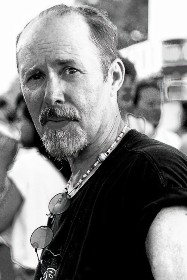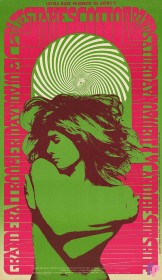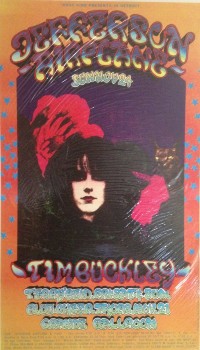An accomplished Michigan artist and illustrator, Carl Lundgren was born in Detroit on July 12, 1947. He was not the kind of artist who had been painting since age three. He was not a quiet, introverted child; on the contrary, he was reportedly a charming, outgoing sort of fellow with a busy social life. Lundgren was not yet twenty years old when he first picked up a drawing pencil, but he quickly became known in the late 1960s for his Grande Ballroom era rock concert posters, postcards, and fantasy art.  Carl Lundgren
Carl Lundgren
Carl Lundgren had an early interest in becoming a fantasy artist and illustrator like his idol Frank Frazetta. At the age of 18, he was co-chairman of the first multimedia science fiction convention, The Detroit Triple Fan Fair, featuring comics, movies and science fiction. He studied with the Famous Artists School correspondence course, for formal training.
Lundgren’s artistic beginnings were greatly influence by the avant-garde. During his senior year in high school, he was a folksinger, playing professionally in local clubs and coffee houses. He also made underground films.
After graduating from high school, Lundgren decided to pursue a career in art, undeterred by the fact that had not yet learned to draw. Subsequently, he attended several California art schools, but he soon realized that the kind of art he wanted to create was largely unteachable. He eventually dropped out of college and became what he considers a self-taught artist. 
His time in California was beneficial in another way, however, as it introduced him to the emerging rock poster scene. Returning to Detroit in 1967, Lundgren met rock poster artist Gary Grimshaw, who was illustrating posters for a Detroit rock venue, run by Russ Gibb, called the Grande Ballroom. Grimshaw offered him a job designing some of the posters. “I still couldn’t draw,” Lundgren recalled, “But I could handle rock poster graphics. Nonetheless, he was a quick learner, and Lundgren went on to create poster art for seminal bands such as The Who, Jefferson Airplane, and Pink Floyd.
When rock concerts had moved on to larger venues and the whole Detroit music scene had changed, Lundgren moved to New York City in 1974 and turned to science fiction and fantasy illustration for a living, painting nearly 300 book covers. During this time, Lundgren became a co-founder of the Association of Science Fiction and Fantasy Artists (ASFA) and was nominated for a Hugo Award for his illustration work.
Carl Lundgren also became an underground comic contributor, editor, and publisher, working with such luminaries as Robert Crumb, and Gilbert Shelton. 
During the 1980s he developed a reputation as one of the country’s foremost book cover illustrators, with countless commissions to his credit from mayor publishers in the fantasy and science fiction fields.
Lundgren quit working for the publishing industry in 1987, choosing to instead to focus on fine art. In 1993 he wrote and published an autobiography called Carl Lundgren, Great Artist. In 1994. Pomegranate Artbooks published a postcard-sized book called The Rock Concert Art of Carl Lundgren, 1967-69. In 2015, Hermes Press published a book by Lundgren on his posters titled The Psychedelic Rock Art of Carl Lundgren.
It has been said that Lundgren’s poster work for the Grande Ballroom and other venues during the late 1960s include many of his greatest creations. His artistic images evoked the excitement of the psychedelic scene, and today they offer are look back at a phenomenon and a genre that were unique in their time and are uniquely treasured in ours.
Carl Lundgren was inducted into the Michigan Rock and Roll Legends Hall of Fame in 2023.
Sources: Wikipedia (Carl Lundgren) and The Rock Concert Art of Carl Lundgren

